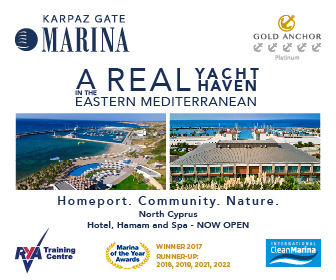Portrait of a Cruiser: German crew Christian, Sabrina, Joshua and Jonathan of Yacht Moya
German cruising parents Christian and Sabrina started long distance cruising in Europe with a baby of 3 months and a toddler. Two years later the family moved on board permanently to circumnavigate. Having reached the Caribbean they are planning on heading to the Pacific next year. If you are wanting to take your young children cruising but still not certain as to how you would handle it, Sabrina and Christian’s insights will inspire and encourage you to go for it and take the leap.
Published 6 years ago


Nationality: German
Boat Name: Moya
Boat Type/Model and Size: Motiva 39S
Home Port: Stuttgart, Germany
Blog: www.sy-moya.de
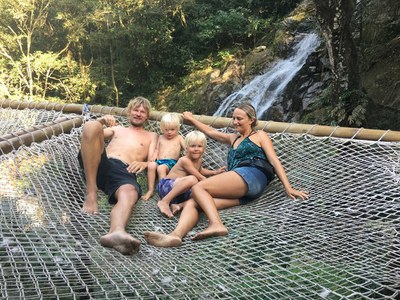

Christian’s sailing life started at his sports club at the age of 21 when a team member asked him to join them for a sailing trip. He instantly was hooked and 4 trips later he already held his skipper‘s license and chartered a boat with crew.
As a schoolgirl, Sabrina had a silly dream about applying to be a deckhand on a square rigger, but she never did. She gained her first sailing experience in Australia taking sailing lessons. She could not manage to integrate sailing into her daily life, however, living hundreds of miles from the sea and knowing nobody who actually sailed.
By happy coincidence, we met on a sailing yacht Christian skippered. We got married and spent our honeymoon on a bareboat in Italy. Ever since we have been passionate vacation cruisers chartering sailing yachts whenever feasible. Naturally, we have been thinking about doing a longer journey for quite a while and finally started to look for a boat, which was quite an ordeal living far from the sea with newly born baby Joshua. When Joshua was 2 months old he visited his first yacht. One year later we were happy owners of our first and only yacht, Moya, a solid steel sloop, which we then equipped for long distance cruising.
When Jonathan was born in 2015 we decided to take some time off work and go on our first long distance journey. We were very privileged as we could both take parental leave to do our trip, spending some time with our kids (at that time 3 months and 2 years old) and exploring the European Atlantic coast. In three months we sailed Moya from the Baltic Sea to Portugal and gave long distance cruising with a baby and a toddler a try. Even though cruising with kids has nothing in common with our previous sailing experience as a couple, we very much enjoyed exploring nature, visiting new places and showing our kids our amazing planet.
Two years later we are off again.
Describe what sort of cruisers you are:
We are a family with two little boys aged 5 and 3, currently living on board and long distance cruising.
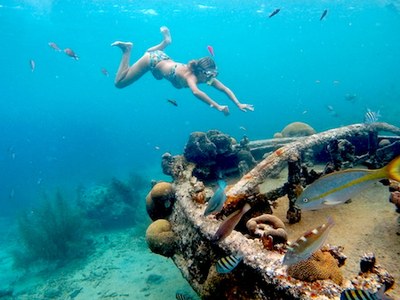

We are doing family cruising along the well-worn track (at least by cruisers) around the globe. We are sailing westbound along the least dangerous route, which many cruisers have travelled before us, avoiding lower latitudes and cyclone seasons. On our way, we are constantly assessing risks and judging whether or not we deem them acceptable. Our risk assessment may differ from other people‘s views but is the basis for most of our decisions. As for the tremendous heterogeneity of our amazing planet, we are travelling relatively quickly. There are so many things we would like to show our kids before they start school. This doesn’t allow us to draw very detailed pictures of the places we have visited but enables a more general overview of how our planet works. At the moment we have no idea whether we will do a full circumnavigation, but after crossing the Atlantic Ocean we just decided to move into the Pacific this year.
What were the key reasons you selected your current boat?
As we are sailing as a family, safety was our first priority when we bought Moya. The boat material was definitely a key factor and as we couldn’t afford aluminium, we accepted the higher maintenance factor of a steel hull. The hull was built by the Danish boat yard Motiva and the remainder of the boat was designed and built by the handy and knowledgeable pre-owners. They spent years optimising the interior and implemented partly unconventional solutions, many of them with backup systems in place. We liked their way of thinking and the fact that they thoroughly selected the next owners for their precious boat, which they sold for personal reasons.
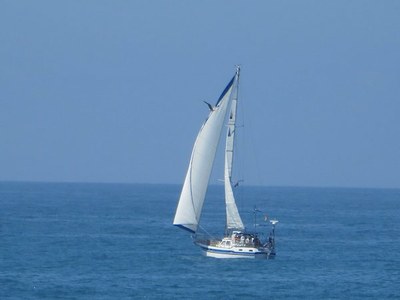

What other boats have you owned?
None.
What changes have you made to your current boat?
Moya is a very strong and safe boat, but she was not ready for long distance cruising when we purchased her. We installed a wind generator, solar panels, a wind vane, a watermaker and SSB radio. Also, we updated her navigation, communication and safety systems and added a life raft, MOBs, a sat phone, a wifi antenna and an AIS transmitter.
Most useful equipment fitted, and the reasons for this choice:
This would be our watermaker and our wind vane.
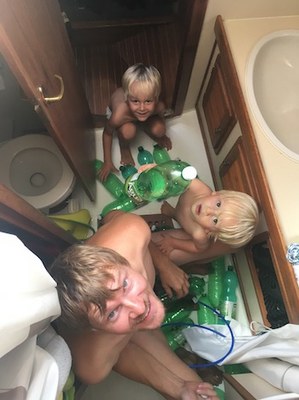

We originally bought our wind vane to have an independent backup system for our electric autopilot. However, it turns out our wind vane does most of the helming when we are on passage, as it works mechanically without electricity, which we are often short on. It also does a great job when going downwind, when the electric autopilot might have some hassle.
Equipment regrets, or things you would do differently:
We wish we had installed more solar panels or a diesel generator as electricity often is limited on Moya, especially when we are running the water maker, which needs a lot of power.
List the countries you have cruised:
With Moya, we visited Germany, Netherlands, Belgium, France, UK, Spain, Portugal, Morocco, Canary Islands, Cape Verde, Martinique, St. Lucia, St. Vincent and the Grenadines, Grenada, Curacao, Venezuela and Columbia. On Charter boats also Turkey, Italy, Australia, Croatia and Greece.
Future cruising plans:
After visiting Panama we plan to transit the Panama Canal into the Pacific Ocean. Afterwards the Galapagos, Marquesas, Tuamotus, Society Islands, Tonga and Fiji are on our list. Thereafter we do not have concrete plans yet. Options are visiting New Zealand or Australia or heading directly north towards Indonesia.
Christian would love to sail the north-west passage between Greenland and Canada and afterwards back to Europe, but if he does he would have to tie me (Sabrina) on board.
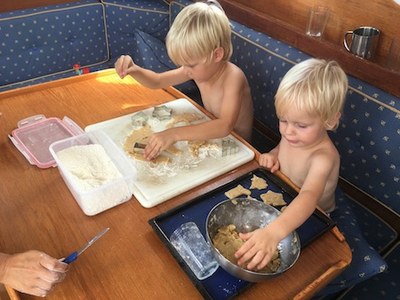

Baltic Sea, Northern Sea, English Channel, Bay of Biscay, Atlantic Ocean, Mediterranean Sea, Caribbean Sea, Aegaen Sea, Marmara Sea.
Approximate sea miles:
20,000 nm (Christian) and 12000 nm (Sabrina)
Scariest day on the water:
Christian‘s scariest day on the water was several years ago when he helped to deliver a newly built sailing vessel from Slovenia across the Mediterranean Sea to Turkey in the Winter. He sailed the yacht down the Adriatic to Bari, then crossed the Ionian Sea to Greece and continued to the Dardanelles and the Marmara Sea. As he sailed in the depth of winter, he experienced snowfall on board, huge seas and violent storm force wind for most of his passage. So far this did not bother him too much and he even enjoyed getting storm sailing lessons from the experienced skipper of the yacht. However, when they hit a thunderstorm in the dead of the night his comfort level dropped significantly. He smiled at the words of the skipper; “the backstay and the mast are almost building a Faraday cage“, but this didn‘t last long. At the helm, he heard thunder immediately followed by lightning striking into the water close to the yacht. “The scariest bit was waiting for the next lightning as you never know whether it will hit the boat. Retrospectively, it was beautiful to see the force of nature, but I prefer not to see it again.“
My (Sabrina) scariest day on the water is still to come, I‘m quite sure about that. So far the scariest moment was a breaking wave as we sailed across a shallow spot on our approach to Hog Island at the southern coast of Grenada. I saw the wave approaching and thought it would land right inside the cockpit, where the children were playing. They were wearing life jackets and lifelines, but I experienced an adrenalin rush anyhow imagining water everywhere and even a knockdown. The wave hit Moya’s stern, but she handled it perfectly and just cruised along.
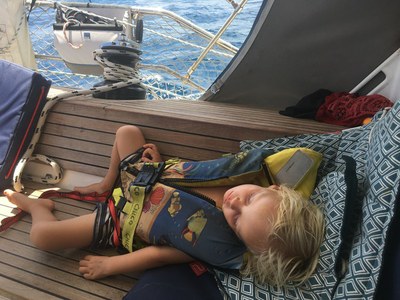

There have been hundreds of brilliant moments since we started cruising. I don‘t think that I can pick the best moment, but I can mention a few with absolutely amazing people we met along our route:
Such as the Moroccan Fisherman who open heartedly raced towards Moya just to welcome us and give us directions on how to best approach the harbour;
And the poor Cape Verdean villagers who wanted to give us fruits instead of selling them;
The boy in St. Vincent approaching Moya with his little rowing boat containing a small basket with just bananas and coconuts, which he proclaimed as his small supermarket, telling little stories full of wide smiles;
Or Adelejo, a stranger who saw the question marks in our faces and just helped us to pay the national park fees in Los Roques, Venezuela;
And the German couple in Curacao who lent us their car so we could go shopping.
None of them ever asked for anything in return.
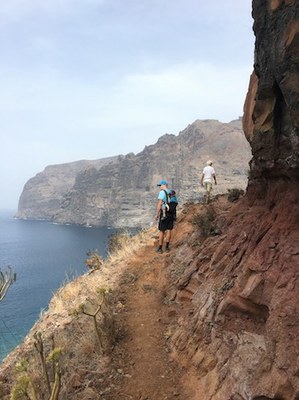

Favourite cruising area and why:
The Aegean Sea both in Greece and Turkey.
Every time we have visited this area, sailing conditions were always close to perfect: little swell but a significant breeze. Distances in between the Greek islands and also the Turkish mainland are ideal for short day trips and still leave sufficient time to explore the islands with their rich cultural heritage. You can select between anchoring in remote bays, tying up in marinas or small fishing villages, all are equally rewarding. People are very nice and the food is just delicious. There is absolutely no room for complaints.
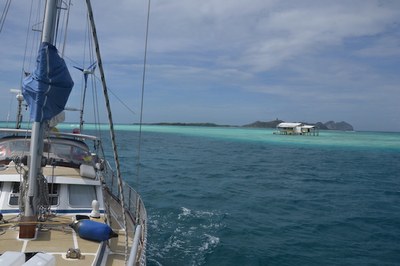

Francis Cay, Los Roques, Venezuela.
This little anchorage is sheltered by reefs and has no swell at all. If you jump off the boat you will dive into aquamarine, translucent water. The beach is white sand with a cute little restaurant, otherwise, the island is uninhabited. For children the cay is perfect for playing in shallow waters, collecting shells and watching the little lizards.
Favourite cruising apps:
Weathertrack, Navionics, Google Earth, OpenCPN
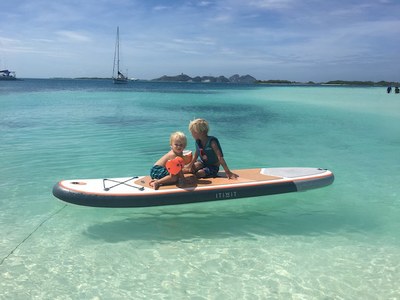

Noonsite of course, we use it almost every day.
Favourite cruising books:
Some cruising guides are making our life so much easier, thus belong definitely to our favourites e.g. Atlantic Islands, Reeds Nautical Almanac. We also use Jimmy Cornell’s World cruising routes a lot for planning our passages.
What advice or message would you want to pass on to anyone new to cruising or thinking about casting off the dock lines?
There are zillions of reasons, including some risks, why not to go cruising especially with kids. Many times people who have never set foot on a sailboat are their strongest advocates. In any case, with every risk comes also a chance, which you can only explore to a certain extent when you talk to qualified people with cruising expertise. It is only if you take the risk that you will discover ultimately what the cruising life brings for you.
Why cruise? In a few sentences, what is it that inspires you to keep cruising?
We always enjoy the arrival in new countries as there are so many new things to explore. Every time we learn something new about nature, culture or people. Sometimes we see significant differences from what we are used to, as different religions and sometimes just tiny little changes, like different coloured street signs. All are letting us recognise that being different from local convention is not only possible but common for most parts of the world.
Cruising is almost like a never-ending source of novel experiences broadening our minds as we go.
We also very much appreciate that we are travelling ecologically, compliant with the force of the wind to beautiful, unspoiled places, which are hardly accessible by any other form of transportation. We feel privileged that we can share this experience with our boys and explore and get to know our terrific planet together with our kids. Being around our two little boys 24/7 sometimes can be tough, but most of the time it is a gift to watch them grow and develop into open-minded, happy people.
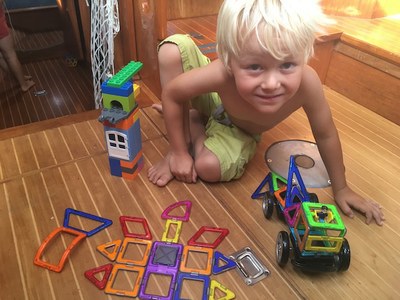

Before going cruising I often asked myself whether we will manage to keep our kids secure and entertained on the boat, especially when sailing longer passages. I was worrying especially how Jonathan would cope being on board when we started our first trip when he was just 3 months old. I tried to read family sailing blogs to prepare myself prior to departure, but it was tedious as the responses to my questions often were hidden between other information. I finally decided not to worry too much and just give family sailing a try.
Retrospectively, I found having a baby on passage was less challenging than I initially thought. As Jonathan was not yet moving, he was happy whenever we were around. While sailing he often was sitting in the cockpit tightly secured in his Maxi-Cosi or was swinging in his baby crib, which we had set up in the saloon. We didn’t leave the harbour in heavy weather, but as we crossed the English Channel and the Bay of Biscay, we almost always had the wind on Moya’s nose and we’re going against rough seas. The boat often was tilted and rocking.
In the beginning, breastfeeding was challenging until I figured out that lying down in a lee berth works well when I was leaning against the hull and Jonathan against myself. Also changing diapers could be tricky while moving. A u-shaped changing mat on our bed worked best to avoid the baby rolling. Christian sometimes had to jump in when I was feeling sick. The smell is really nasty if you feel already a bit sick.
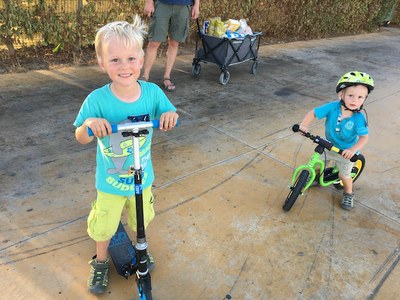

As the kids love going by dingy and we are exploring the Caribbean now, we also changed our habit of going to marinas and most of the time are at anchor, which is much nicer for the boys as they can jump directly into the water when they are getting too hot or energy levels are increasing too much.
We are very lucky that the boys are not getting sick while at sea, thus we can focus on managing our daily routine. Before we started to cross the Atlantic we discussed back and forth whether to take the additional crew on board to get support for the watches and household duties. The tight space on Moya and little privacy on board, plus the fact that we would have had to take a stranger, meant we decided against it and crossed the ocean as a family of four. During the night that meant the Christian and I were doing the watches in shifts. I went to bed with the kids as soon as the sun set, started my first watch at eleven and my second at five or six in the morning.
Often the boys were getting up at dawn and sharing part of my morning watch before we had breakfast together when Christian got up. At that time of the day, we often played board games or read a book. During the day we had no fixed schedule for the watches. As we were mainly going by wind vane, there was a lot of time to do things between the obligatory lookout for other ships every 10 minutes. Time went by quickly while playing board games, Lego and magnets, colouring, reading, dancing, baking, cooking, washing diapers, fishing, navigating and radioing. When seas were rough the kids started to listen to stories on CD. They also slept, which they wouldn’t go ashore. Luckily they were never scared or had a problem finding sleep.
When Christian and I both had to work on the sails, the boys had to stay inside and were mostly playing in Joshua’s cabin, where all the toys are. When playing outside, both boys wear self-inflatable lifevests, a man overboard beacon and lifelines at all times.
Cruising with Kids is definitely very different from adult sailing trips, sometimes a bit tiresome, but equally enjoyable and maybe even more rewarding.
Editor’s Note: If you think you have an interesting story to tell and would like to take part in our Portrait of a Cruiser series, please contact Sue at editor@noonsite.com for a questionnaire.
Related to following destinations: Germany
Related to the following Cruising Resources: Circumnavigation, Cruising with Children, Portrait of a Cruiser




